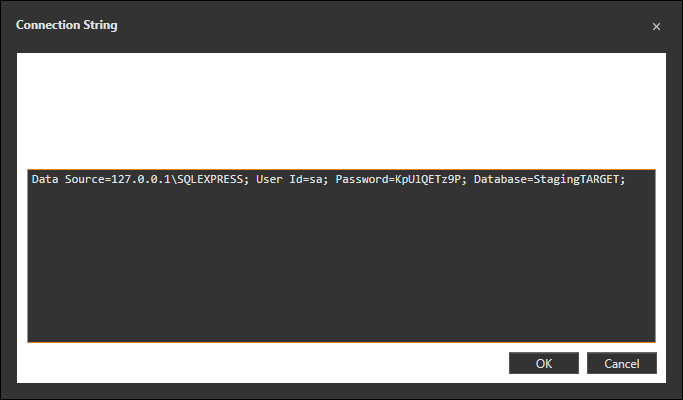Hi there,
We have been using SambaPOSv5 for a while and it is all set up, though I am new to the business and unfamiliar with it.
On Friday it suddenly would not start and gets stuck at the loading screen with the error message - “Please restart application. Current problem can be found in the log file” (or something very close to that effect).
I have copied and pasted the log file below - can anyone help me with how to fix the problem? It mentions something about the login having failed, but I do not know where to find or fix these login details (or database connection if that is the problem).
Samba is just installed on a single computer, I do not believe we are running SQL server. At least, I certainly cannot find that as a program on the computer. Just Samba as a local application.
Please, please help.
Thank you, Matt
2022-07-18 12:57
[General Info]
Application: SambaPOS
Version: 5.3.6
Region: en
DB: SQ
Machine: DESKTOP-DQM1TBJ
User: outof
Date: 2022-07-18
Time: 16:57
User Explanation:
outof said “”
[Exception Info 1]
Top-level Exception
Type: System.Data.DataException
Message: An exception occurred while initializing the database. See the InnerException for details.
Source: EntityFramework
Stack Trace: at System.Data.Entity.Internal.InternalContext.PerformInitializationAction(Action action)
at System.Data.Entity.Internal.InternalContext.PerformDatabaseInitialization()
at System.Data.Entity.Internal.LazyInternalContext.<>c.b__58_0(InternalContext c)
at System.Data.Entity.Internal.RetryAction1.PerformAction(TInput input) at System.Data.Entity.Internal.LazyInternalContext.InitializeDatabaseAction(Action1 action)
at System.Data.Entity.Internal.LazyInternalContext.InitializeDatabase()
at System.Data.Entity.Internal.InternalContext.Initialize()
at System.Data.Entity.Internal.InternalContext.ForceOSpaceLoadingForKnownEntityTypes()
at System.Data.Entity.DbContext.System.Data.Entity.Infrastructure.IObjectContextAdapter.get_ObjectContext()
at Samba.Infrastructure.Data.SqlData.EFWorkspace…ctor(CommonDbContext context)
at Samba.Persistance.Data.WorkspaceFactory.Create()
at Samba.Presentation.Services.Common.DataGeneration.DataCreationService.get_Workspace()
at Samba.Presentation.Services.Common.DataGeneration.DataCreationService.ShouldCreateData()
at Samba.Presentation.Services.Common.DataGeneration.DataCreationService.CreateData()
at Samba.Presentation.Bootstrapper.InitializeShell()
Inner Exception 1
Type: System.Data.Entity.Core.EntityException
Message: The underlying provider failed on Open.
Source: EntityFramework
Stack Trace: at System.Data.Entity.Core.EntityClient.EntityConnection.Open()
at System.Data.Entity.Core.Objects.ObjectContext.EnsureConnection(Boolean shouldMonitorTransactions)
at System.Data.Entity.Core.Objects.ObjectContext.ExecuteInTransaction[T](Func1 func, IDbExecutionStrategy executionStrategy, Boolean startLocalTransaction, Boolean releaseConnectionOnSuccess) at System.Data.Entity.Core.Objects.ObjectContext.<>c__DisplayClass186_01.b__0()
at System.Data.Entity.Infrastructure.DefaultExecutionStrategy.Execute[TResult](Func1 operation) at System.Data.Entity.Core.Objects.ObjectContext.ExecuteStoreQueryReliably[TElement](String commandText, String entitySetName, ExecutionOptions executionOptions, Object[] parameters) at System.Data.Entity.Core.Objects.ObjectContext.ExecuteStoreQuery[TElement](String commandText, Object[] parameters) at Samba.Persistance.Data.Initializer.InitializeDatabase(DataContext context) at System.Data.Entity.Internal.InternalContext.<>c__DisplayClass66_01.b__0()
at System.Data.Entity.Internal.InternalContext.PerformInitializationAction(Action action)
Inner Exception 2
Type: System.Data.SqlClient.SqlException
Message: Cannot open database “SambaPOS5” requested by the login. The login failed.
Login failed for user ‘DESKTOP-DQM1TBJ\outof’.
Source: .Net SqlClient Data Provider
Stack Trace: at System.Data.SqlClient.SqlInternalConnectionTds…ctor(DbConnectionPoolIdentity identity, SqlConnectionString connectionOptions, SqlCredential credential, Object providerInfo, String newPassword, SecureString newSecurePassword, Boolean redirectedUserInstance, SqlConnectionString userConnectionOptions, SessionData reconnectSessionData, DbConnectionPool pool, String accessToken, Boolean applyTransientFaultHandling, SqlAuthenticationProviderManager sqlAuthProviderManager)
at System.Data.SqlClient.SqlConnectionFactory.CreateConnection(DbConnectionOptions options, DbConnectionPoolKey poolKey, Object poolGroupProviderInfo, DbConnectionPool pool, DbConnection owningConnection, DbConnectionOptions userOptions)
at System.Data.ProviderBase.DbConnectionFactory.CreatePooledConnection(DbConnectionPool pool, DbConnection owningObject, DbConnectionOptions options, DbConnectionPoolKey poolKey, DbConnectionOptions userOptions)
at System.Data.ProviderBase.DbConnectionPool.CreateObject(DbConnection owningObject, DbConnectionOptions userOptions, DbConnectionInternal oldConnection)
at System.Data.ProviderBase.DbConnectionPool.UserCreateRequest(DbConnection owningObject, DbConnectionOptions userOptions, DbConnectionInternal oldConnection)
at System.Data.ProviderBase.DbConnectionPool.TryGetConnection(DbConnection owningObject, UInt32 waitForMultipleObjectsTimeout, Boolean allowCreate, Boolean onlyOneCheckConnection, DbConnectionOptions userOptions, DbConnectionInternal& connection)
at System.Data.ProviderBase.DbConnectionPool.TryGetConnection(DbConnection owningObject, TaskCompletionSource1 retry, DbConnectionOptions userOptions, DbConnectionInternal& connection) at System.Data.ProviderBase.DbConnectionFactory.TryGetConnection(DbConnection owningConnection, TaskCompletionSource1 retry, DbConnectionOptions userOptions, DbConnectionInternal oldConnection, DbConnectionInternal& connection)
at System.Data.ProviderBase.DbConnectionInternal.TryOpenConnectionInternal(DbConnection outerConnection, DbConnectionFactory connectionFactory, TaskCompletionSource1 retry, DbConnectionOptions userOptions) at System.Data.ProviderBase.DbConnectionClosed.TryOpenConnection(DbConnection outerConnection, DbConnectionFactory connectionFactory, TaskCompletionSource1 retry, DbConnectionOptions userOptions)
at System.Data.SqlClient.SqlConnection.TryOpenInner(TaskCompletionSource1 retry) at System.Data.SqlClient.SqlConnection.TryOpen(TaskCompletionSource1 retry)
at System.Data.SqlClient.SqlConnection.Open()
at System.Data.Entity.Infrastructure.Interception.DbConnectionDispatcher.<>c.b__13_0(DbConnection t, DbConnectionInterceptionContext c)
at System.Data.Entity.Infrastructure.Interception.InternalDispatcher1.Dispatch[TTarget,TInterceptionContext](TTarget target, Action2 operation, TInterceptionContext interceptionContext, Action3 executing, Action3 executed)
at System.Data.Entity.Infrastructure.Interception.DbConnectionDispatcher.Open(DbConnection connection, DbInterceptionContext interceptionContext)
at System.Data.Entity.Core.EntityClient.EntityConnection.b__55_0()
at System.Data.Entity.Infrastructure.DefaultExecutionStrategy.Execute(Action operation)
at System.Data.Entity.Core.EntityClient.EntityConnection.Open()
[Assembly Info]
mscorlib, Version=4.0.0.0
PresentationFramework, Version=4.0.0.0
PresentationCore, Version=4.0.0.0
System, Version=4.0.0.0
WindowsBase, Version=4.0.0.0
Samba.Services, Version=5.3.7816.39267
System.ComponentModel.Composition, Version=4.0.0.0
System.Configuration, Version=4.0.0.0
DevExpress.Xpf.Core.v17.2, Version=17.2.13.0
System.Xaml, Version=4.0.0.0
Microsoft.Practices.Prism.MefExtensions, Version=4.0.0.0
Samba.Presentation.Services, Version=5.3.7816.39270
Samba.Presentation.Common, Version=5.3.7816.39273
System.Drawing, Version=4.0.0.0
Samba.Domain, Version=5.3.7816.39266
Microsoft.Practices.Prism, Version=4.0.0.0
System.Core, Version=4.0.0.0
Samba.Infrastructure, Version=5.3.7816.39262
DevExpress.Data.v17.2, Version=17.2.13.0
Microsoft.Practices.ServiceLocation, Version=1.0.0.0
Samba.Localization, Version=5.3.7816.39263
Samba.Persistance, Version=5.3.7816.39267
FastButton, Version=1.0.0.0
[System Info]
Operating System
-Microsoft Windows 10 Home
–CodeSet = 1252
–CSDVersion =
–CurrentTimeZone = -240
–FreePhysicalMemory = 1100880
–OSArchitecture = 64-bit
–OSLanguage = 1033
–ServicePackMajorVersion = 0
–ServicePackMinorVersion = 0
–Version = 10.0.19044
Machine
-DESKTOP-DQM1TBJ
–Manufacturer = Dell Inc.
–Model = Inspiron 3275 AIO
–TotalPhysicalMemory = 4156350464
–UserName = DESKTOP-DQM1TBJ\outof
######################### E N D #########################
